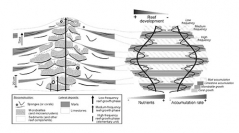

 Comptes Rendus Palevol
6 (1-2) - Pages 21-36
Comptes Rendus Palevol
6 (1-2) - Pages 21-36During the Jurassic, coral and sponge reefs were particularly widespread along the northwestern Tethys. These bioconstructions occurred from shallow- to deep-shelf settings, in pure carbonate, carbonate-dominated or clay-rich mixed carbonate-siliciclastic sedimentary contexts. According to the depositional environment, the amount of microbialites strongly fluctuates, to form up to 70% of the reef volume. This study focuses on bioconstructions where microbialites constitute at least 15% of the reef volume. Analysis of the close relationships between the reef structures and the stacking pattern of laterally-deposited sediments reveals analogous architectures and growth modes between coral- and sponge-microbialite bioconstructions. Firstly, corals or sponges erected a primary framework more or less projected above the sea floor (constratal or superstratal growth fabrics). Contemporaneously, a thin microbialite layer encrusted the local dead parts of corals or sponges. In a second stage, microbialites largely developed and entirely covered the reef surface, becoming the main reef builders. The whole development of coral- and sponge-microbialite reefs corresponds to a ‘low-frequency reef-growth phase’. These bioconstructions also display surfaces of reef growth interruption delimiting ‘medium-frequency reef-growth phases’. They include several ‘high-frequency reef-growth phases’ (or elementary units) corresponding to coral or sponge frameworks plus microbialite crusts. At the scale of the elementary unit, microbialites are interpreted to reflect nutrient-richer conditions and developed to the detriment of phototrophic-, mixed- or heterotrophic-dominated assemblages of corals or sponges. The development of Jurassic coral and sponge bioconstructions was punctuated by high-frequency (millennial time-scale) ecological crises during which microbialites occurred at the reef surface. Such ecological shifts from skeletal reef metazoans (i.e. corals or sponges) to microbialite crusts were recorded whatever the palaeogeographical position (shallow-proximal platform or deep-distal shelf) along the northwestern Tethys margin. Three main orders of climatic oscillations, correlated to the ‘high-, medium- and low-frequency reef-growth phases’, could have directly regulated the amount of terrigenous materials and nutrients delivered to the ocean, which in turn controlled platform carbonate production and accumulation, as well as reef development.
Coral and sponge reefs, microbialites, nutrients, accumulation rate, palaeoenvironments, Jurassic